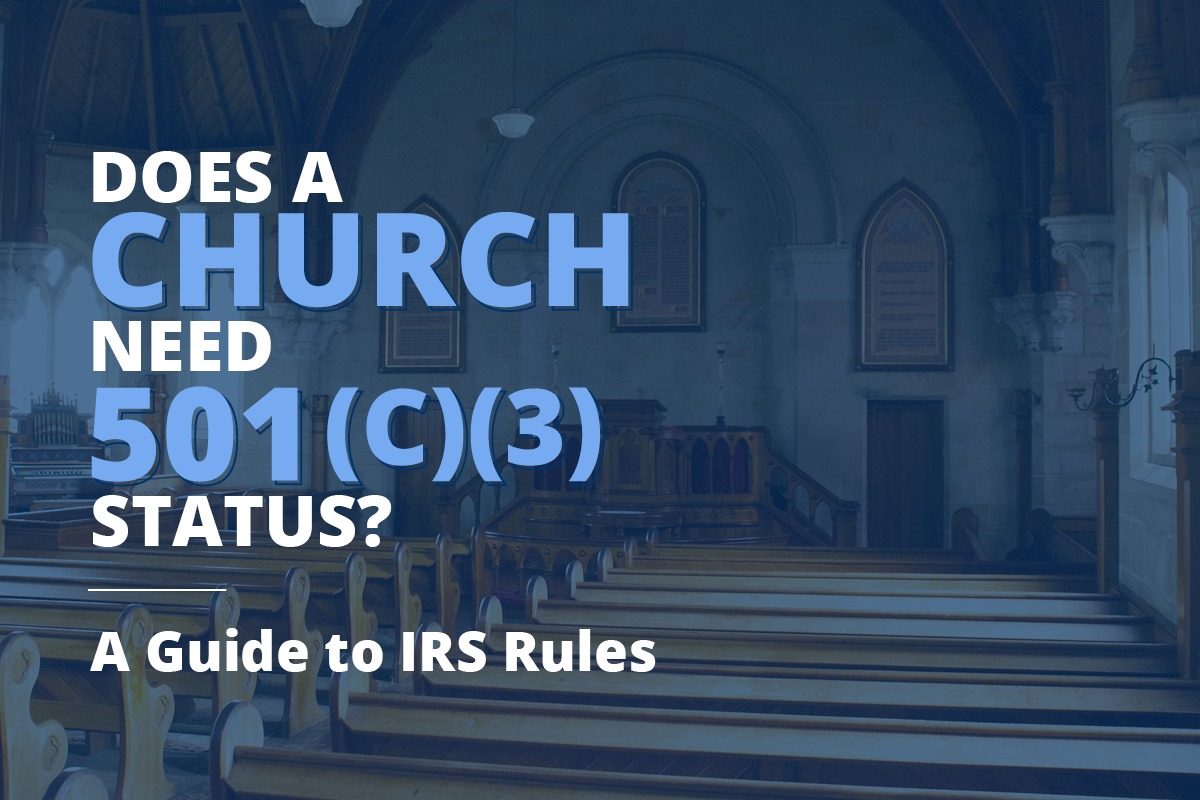

Finance
How To Dissolve A 501(C)3 With The IRS
Published: October 31, 2023
Learn the step-by-step process to dissolve a 501(C)3 organization with the IRS. Expert guidance and tips to navigate the financial aspects involved in this process.
(Many of the links in this article redirect to a specific reviewed product. Your purchase of these products through affiliate links helps to generate commission for LiveWell, at no extra cost. Learn more)
Table of Contents
- Introduction
- Understanding 501(c)(3) Organizations
- Reasons for Dissolving a 501(c)(3)
- Preparing for Dissolution
- Informing Board Members and Key Stakeholders
- Filing the Appropriate Forms with the IRS
- Settling Outstanding Debts and Obligations
- Distribution of Assets
- Obtaining Final IRS Determination
- Notifying the Public and Closing Operations
- Conclusion
Introduction
Operating a 501(c)(3) organization can be a rewarding experience. These organizations, also known as nonprofit organizations, focus on charitable, educational, religious, or scientific purposes and enjoy various tax benefits. However, there may come a time when it is necessary to dissolve a 501(c)(3) organization with the Internal Revenue Service (IRS).
Dissolving a 501(c)(3) organization involves a series of steps and requires careful consideration of legal and financial obligations. This article will provide a step-by-step guide on how to dissolve a 501(c)(3) organization with the IRS, ensuring that all necessary requirements are met.
Before proceeding with the dissolution process, it is essential to understand the implications and responsibilities associated with dissolving a 501(c)(3) organization. It is crucial to consult with legal and financial professionals to ensure compliance with state and federal laws.
Additionally, it is important to note that the information provided in this article is for general guidance purposes only and should not be considered as legal or financial advice. Each 501(c)(3) organization’s circumstances may vary, and seeking professional advice tailored to your specific situation is strongly recommended.
Now, let’s delve into the details of dissolving a 501(c)(3) organization and ensure a smooth transition with the IRS.
Understanding 501(c)(3) Organizations
Before embarking on the process of dissolving a 501(c)(3) organization, it is crucial to have a clear understanding of what it entails. A 501(c)(3) organization is a nonprofit entity recognized by the IRS as having a tax-exempt status. These organizations are formed for purposes such as charitable, religious, educational, scientific, or literary activities.
One of the primary benefits of obtaining a 501(c)(3) status is the ability to receive tax-deductible donations. Donors can deduct their contributions from their taxable income, incentivizing them to support the organization’s mission.
501(c)(3) organizations are subject to certain rules and regulations set forth by the IRS. These include restrictions on political activities, limitations on private benefits to individuals, and the requirement to operate exclusively for exempt purposes. The organization’s bylaws should outline these restrictions and ensure compliance.
Nonprofit organizations have a board of directors responsible for overseeing the management and operations of the organization. The board plays a critical role in decision-making, financial management, and ensuring the organization’s activities align with its mission.
Understanding the structure and purpose of a 501(c)(3) organization is vital when it comes to dissolving it. It is essential to comply with the legal and procedural requirements to ensure a smooth dissolution process and maintain the organization’s integrity throughout.
Now that we have a basic understanding of 501(c)(3) organizations, let’s explore the reasons why an organization may choose to dissolve.
Reasons for Dissolving a 501(c)(3)
There are various reasons why a 501(c)(3) organization may choose to dissolve. It is important to carefully evaluate the organization’s circumstances and ensure that dissolution is the most appropriate course of action. Here are some common reasons for dissolving a 501(c)(3) organization:
- Mission Accomplished: Sometimes, a nonprofit organization may have fulfilled its mission or achieved its goals, making its continued existence unnecessary. If the organization has successfully addressed the issue or cause it was created to tackle, dissolving may be a logical step.
- Financial Difficulties: Financial hardships and ongoing deficits can significantly impact a 501(c)(3) organization’s ability to fulfill its mission. If the organization is unable to secure sustainable funding or recover from financial challenges, dissolution may be considered to mitigate further losses.
- Lack of Resources: Nonprofit organizations rely on dedicated staff, committed volunteers, and sufficient resources to carry out their operations effectively. If a 501(c)(3) organization finds itself with a significant shortage of human and financial resources, dissolution might be a practical solution.
- Strategic Shift: Organizations, as they evolve, may decide to shift their focus or change their strategies to address emerging needs or align with current trends. In such cases, a 501(c)(3) organization may choose to dissolve its current structure and reorganize in a different form to better meet its new objectives.
- Legal Issues: Serious legal troubles, such as loss of tax-exempt status, fraudulent activities, or violations of regulations, can jeopardize the reputation and long-term viability of a nonprofit organization. In extreme cases, dissolution may be necessary to address and resolve these legal issues.
It is important for the board of directors and key stakeholders to carefully assess the circumstances and motivations leading to the decision to dissolve. Engaging in open and transparent communication channels with all involved parties is crucial to ensure a smooth and respectful dissolution process.
With an understanding of the reasons for dissolving a 501(c)(3) organization, let’s explore the necessary steps to prepare for the dissolution process.
Preparing for Dissolution
Before officially dissolving a 501(c)(3) organization, it is important to take several key steps to ensure a smooth process and meet all legal requirements. These steps include:
- Reviewing Governing Documents: Start by reviewing the organization’s governing documents, such as the articles of incorporation, bylaws, and any other relevant policies. These documents will outline the procedures and requirements for dissolution, including any specific provisions that must be followed.
- Board Approval: Obtain formal approval from the board of directors to dissolve the organization. This typically involves holding a board meeting, documenting the decision in the meeting minutes, and ensuring that a sufficient number of board members are present and in favor of dissolution.
- Legal and Financial Consultation: Seek advice from legal and financial professionals who specialize in nonprofit law. They can provide guidance on the legal obligations and ensure compliance with federal and state regulations during the dissolution process.
- Asset Inventory: Take an inventory of the organization’s assets, including cash, property, equipment, and intellectual property. It is crucial to understand the value and ownership of these assets to properly distribute or transfer them during the dissolution process.
- Notification of Funding Sources: Inform any grantors, donors, and funding sources of the organization’s intention to dissolve. Discuss any necessary actions or obligations that must be fulfilled, such as returning unused funds or fulfilling grant requirements before ceasing operations.
- Employee and Staff Communication: Notify employees and staff about the organization’s decision to dissolve. Provide them with the necessary information regarding their employment status, benefits, and any potential severance packages or assistance with job placement.
- Document Retention: Establish a plan for retaining and organizing essential documents and records. Some documents may need to be maintained for a specific period, as required by law or for audit purposes.
- Public Announcement: When the decision to dissolve is final, prepare a statement or press release to announce the organization’s dissolution to the public. Include information about the reasons for dissolution and any plans for the future, such as transferring programs or assets to another organization.
By thoroughly preparing for dissolution, organizations can ensure that all necessary steps are taken, reducing the risks of legal complications and facilitating a smoother transition. Now, let’s move on to the next section and explore the process of informing board members and key stakeholders about the organization’s decision to dissolve.
Informing Board Members and Key Stakeholders
When a decision has been made to dissolve a 501(c)(3) organization, it is crucial to inform and involve board members and key stakeholders throughout the process. Open and transparent communication ensures that everyone is aware of the decision and understands their roles and responsibilities. Here are the steps to effectively inform board members and key stakeholders:
- Board Meeting: Schedule a special board meeting to discuss the decision to dissolve. Provide board members with advance notice and an agenda outlining the purpose and items to be discussed. During the meeting, present the reasons for the dissolution and allow board members to ask questions and offer input.
- Meeting Minutes: Document the board meeting minutes, including the discussion, decision, and any dissenting opinions. These minutes will serve as an official record of the decision-making process and should be retained as part of the organization’s dissolution documentation.
- Individual Communication: After the board meeting, individually communicate with board members to ensure they fully understand the decision and their responsibilities moving forward. Address any concerns or questions they may have and provide an opportunity for further discussion, if needed.
- Key Stakeholders: Identify and communicate with key stakeholders, such as major donors, partner organizations, and community leaders, about the organization’s decision to dissolve. Explain the reasons behind the decision and outline any plans for transitioning programs, services, or assets to other organizations.
- Transparency: Maintain transparency throughout the dissolution process. Keep stakeholders informed about the progress and milestones, such as filing paperwork with the IRS and settling outstanding obligations. Regularly communicate updates through newsletters, emails, or other appropriate channels.
- Listening to Feedback: Encourage board members and key stakeholders to provide feedback and suggestions during the dissolution process. Their insights can help navigate challenges and identify opportunities for a smoother transition.
- Thanking Supporters: Express gratitude to board members, donors, volunteers, and other supporters who have been instrumental in the organization’s journey. Recognize their contributions and acknowledge their role in the organization’s impact and achievements.
By actively involving the board members and key stakeholders, organizations can ensure that the dissolution process is carried out with transparency and collaboration. In the next section, we will discuss the necessary forms to file with the IRS when dissolving a 501(c)(3) organization.
Filing the Appropriate Forms with the IRS
Once the decision to dissolve a 501(c)(3) organization has been made and board members and key stakeholders have been informed, the next step is to file the appropriate forms with the IRS. It is crucial to complete these forms accurately and submit them in a timely manner to ensure compliance with IRS regulations. Here are the key forms to file:
- Form 990: Nonprofit organizations are required to file Form 990 annually to report their financial activities to the IRS. When it comes time to dissolve the organization, a final Form 990 must be filed for the year in which the dissolution occurs. This form provides a snapshot of the organization’s financial situation before the dissolution.
- Form 990 Schedule N: If the organization has engaged in any significant activities during the year leading up to the dissolution, such as lobbying or political campaign activities, Form 990 Schedule N may need to be completed. This form provides details on any such activities.
- Form 990 Schedule O: Schedule O of Form 990 allows organizations to provide additional explanations and disclosures. It is important to utilize this form to explain the circumstances surrounding the dissolution and any significant decisions made during the process.
- Form 1023 or 1023-EZ: If the organization obtained tax-exempt status through the submission of Form 1023 or 1023-EZ, a final version of this form must be filed to request the formal dissolution of the organization. This notifies the IRS of the organization’s intention to cease operations.
- Form 966: Form 966, or the Corporate Dissolution or Liquidation form, must be submitted to the IRS within 30 days after the dissolution of the organization. This form provides essential information about the date of dissolution and the distribution of assets.
It is important to familiarize yourself with the instructions for each form and to carefully complete them. Any errors or omissions can lead to delays or potential issues during the dissolution process. Additionally, keep copies of all submitted forms and supporting documentation for future reference and compliance purposes.
Once the necessary forms have been filed with the IRS, the organization can proceed with settling any outstanding debts and obligations. In the next section, we will discuss this critical step in the dissolution process.
Settling Outstanding Debts and Obligations
As part of the dissolution process for a 501(c)(3) organization, it is crucial to address any outstanding debts and obligations. Failing to do so can have legal and financial consequences for the organization and its board members. Here are the key steps to follow when settling outstanding debts and obligations:
- Identify and Prioritize Debts: Begin by compiling a list of all outstanding debts, including loans, bills, contracts, and any other financial obligations. Prioritize the debts based on their urgency and legal requirements.
- Communicate with Creditors: Reach out to each creditor and inform them of the organization’s decision to dissolve. Discuss repayment plans or negotiate settlements, if necessary. Ensure proper documentation of all communication and agreements reached with creditors.
- Review Contracts and Agreements: Carefully examine all existing contracts, leases, and agreements to determine any obligations or penalties associated with terminating them early. Consult legal counsel, if needed, to ensure compliance with contractual obligations.
- Disposition of Assets: Determine how the organization’s assets will be used to settle outstanding debts. It may be necessary to sell assets, liquidate investments, or negotiate with creditors to reach an agreement on the use of assets to satisfy debts.
- Complete Required Payments: Make arrangements to pay off debts in the order of priority. This may involve making lump-sum payments, setting up payment plans, or seeking legal assistance to negotiate settlements.
- Document Settlements: Maintain detailed records of all debt settlements and payments made. Keep copies of all communication, agreements, and receipts as evidence of fulfilling financial obligations during the dissolution process.
- Tax Implications: Consult with a tax professional to understand the tax implications of settling debts and obligations. Some debts may be tax-deductible, while others may have potential tax consequences.
By taking thorough steps to settle outstanding debts and obligations, the organization can ensure a responsible and lawful dissolution process. However, it is important to note that depending on the complexity of the debts and obligations, it may be necessary to seek professional legal and financial advice throughout this process.
Now that we have addressed the settlement of outstanding debts, let’s explore the next step in the dissolution process: the distribution of assets.
Distribution of Assets
During the dissolution process of a 501(c)(3) organization, it is essential to carefully distribute its assets in compliance with legal requirements and the organization’s governing documents. Properly handling the distribution of assets ensures transparency, accountability, and upholds the organization’s mission. Here are the steps to consider for the distribution of assets:
- Asset Inventory: Begin by conducting a thorough inventory of all the organization’s assets, including cash, property, equipment, and intellectual property. This inventory will serve as a reference for the distribution process.
- Review Governing Documents: Refer to the organization’s governing documents, such as the articles of incorporation, bylaws, or any specific asset transfer provisions. These documents may outline specific guidelines for the distribution of assets.
- Identify Beneficiary Organizations: Identify potential beneficiary organizations that align with the mission and purpose of the dissolving organization. Consider organizations with similar goals or programs that can continue the work and impact of the original organization.
- Transfer of Restricted Assets: If the organization possesses restricted assets, such as grants or endowments, ensure that these assets are transferred to organizations or entities with similar restrictions and purposes.
- Board Approval: Seek formal approval from the board of directors for the proposed plan of asset distribution. Document the approval in the board meeting minutes to demonstrate compliance with legal requirements.
- Asset Valuation: Determine the value of each asset to facilitate fair and equitable distribution. This may require appraisals or professional assessments, especially for high-value assets such as real estate or valuable collections.
- Execute Legal Documents: Prepare legal documents, such as contracts or deeds, to formally transfer ownership or rights of the assets to the identified beneficiary organizations. Engage legal counsel to ensure the proper drafting and execution of these documents.
- Notify Beneficiary Organizations: Reach out to the beneficiary organizations to inform them of their selection and provide them with the necessary documentation and instructions for the asset transfer. Open communication channels to address any questions or concerns they may have.
- Financial Reporting: Maintain accurate financial records of asset distribution, including documentation of transfers, receipts, and acknowledgments from beneficiary organizations. These records will serve as evidence of compliance and transparency during the dissolution process.
Properly distributing the organization’s assets ensures that the work and impact of the organization can continue through the recipient organizations. By following these steps and seeking professional advice where necessary, the organization can fulfill its responsibilities and honor its legacy.
Next, we will explore the process of obtaining final IRS determination and the importance of notifying the public and closing operations.
Obtaining Final IRS Determination
Obtaining final determination from the Internal Revenue Service (IRS) is a crucial step in the dissolution process of a 501(c)(3) organization. This determination certifies the organization’s official termination of tax-exempt status and ensures compliance with IRS regulations. Here’s what you need to know about obtaining final IRS determination:
- File Form 990: Before seeking final determination, ensure that the organization has filed all required Form 990 filings, including the final Form 990 for the year of dissolution. This provides the IRS with a comprehensive understanding of the organization’s financial activities leading up to its dissolution.
- Notification to the IRS: Inform the IRS of the organization’s intent to dissolve by submitting documentation, such as the final Form 990 and a formal letter stating the organization’s decision to terminate. Include any relevant supporting documents outlined by the IRS for the dissolution process.
- Pay Outstanding Taxes: Ensure that all outstanding taxes, including income taxes, employment taxes, and any other applicable taxes, have been paid. This may involve working with an accountant or tax professional to determine and settle any remaining tax obligations.
- Cooperate with IRS Inquiries: Be prepared to respond to any inquiries or requests for additional information from the IRS. Promptly provide the requested documentation or clarification to ensure a smooth process and avoid delays in obtaining the final determination.
- Formal Determination Letter: Upon review of the organization’s documentation and confirmation of compliance with all requirements, the IRS will issue a formal determination letter acknowledging the organization’s dissolution and termination of tax-exempt status.
- Retain Documentation: Keep a copy of the final determination letter as part of the organization’s official records. This letter serves as evidence of the organization’s dissolution and can be important for future reference, audits, or compliance check-ups.
- Notify State and Local Authorities: Depending on the jurisdiction and applicable state laws, it may be necessary to notify state and local authorities of the organization’s dissolution. Consult with legal counsel or a nonprofit specialist to understand any additional requirements beyond the IRS process.
Obtaining final IRS determination is a significant milestone in the dissolution process. It ensures that the organization has fulfilled its legal obligations and can officially conclude its operations. By following the necessary steps and maintaining open communication with the IRS, organizations can streamline the process and achieve a successful final determination.
With the final IRS determination in hand, the next step is to notify the public, stakeholders, and close down the organization’s operations. Let’s explore this final phase in the dissolution process.
Notifying the Public and Closing Operations
As a 501(c)(3) organization reaches the final stages of dissolution, it is crucial to notify the public, stakeholders, and close down operations in an organized and respectful manner. This ensures transparency, maintains trust, and allows for a smooth transition. Here’s what you need to consider when notifying the public and closing operations:
- Public Announcement: Craft a concise and informative public announcement to inform the community, supporters, and stakeholders about the organization’s decision to dissolve. Explain the reasons behind the dissolution, express gratitude for their support, and provide any relevant information about the next steps.
- Website and Social Media: Update the organization’s website and social media platforms to reflect the decision to dissolve. Provide clear messaging about the closure and direct visitors to any necessary resources or contact information for further inquiries.
- Clearing Obligations: Fulfill any outstanding obligations to clients, participants, or beneficiaries of the organization’s programs or services. Communicate effectively with them to ensure a smooth transition and offer referrals or resources for continued support, if applicable.
- Volunteer and Staff Transition: Communicate the organization’s closure to volunteers and staff members. Provide them with appropriate notice, information about their employment status, and any available resources to assist in their transition to new opportunities.
- Proper Disposal of Assets: Dispose of any remaining assets in accordance with applicable laws and regulations. Determine if assets need to be sold, transferred, or donated to other organizations. Keep records of the asset disposal for future reference.
- Record Retention: Maintain all essential records and documents pertaining to the organization’s operations, financials, and dissolution process. These records may be required for legal, tax, or audit purposes in the future.
- Final Financial Reporting: Prepare final financial statements, including a balance sheet and an income statement, to provide a comprehensive overview of the organization’s financial affairs up to the date of dissolution. Ensure compliance with all financial reporting requirements.
- Legal Dissolution: Follow the legal requirements for dissolving a nonprofit organization based on state laws. This may involve filing dissolution paperwork with the appropriate state authorities or agencies, as well as fulfilling any financial or reporting obligations.
- Closure of Bank Accounts: Close the organization’s bank accounts once all financial obligations have been settled. Ensure that all outstanding checks or payments have cleared and notify the bank of the organization’s closure.
- Maintaining Professionalism: Throughout the process, maintain professionalism and respect for all involved parties. Respond to inquiries, concerns, or expressions of support with dignity and gratitude for the organization’s impact.
By diligently notifying the public, stakeholders, and closing operations in a systematic manner, the organization can conclude its activities on a positive note and maintain its reputation in the community. It is essential to approach this phase with care and empathy to honor the organization’s legacy and the relationships it has built.
As we conclude this guide, it is important to remember that the dissolution process of a 501(c)(3) organization can vary depending on the specific circumstances and legal requirements. Seeking the guidance of legal and financial professionals well-versed in nonprofit law is crucial to ensure compliance and a smooth transition.
Conclusion
Dissolving a 501(c)(3) organization with the IRS is a significant decision that requires careful planning, compliance with legal requirements, and open communication. By understanding the various steps involved in the dissolution process, organizations can ensure a smooth transition while honoring their mission and responsibilities.
We began by understanding what a 501(c)(3) organization is and the benefits it offers. We then explored the common reasons for dissolution, such as mission accomplishment, financial difficulties, and strategic shifts. Proper preparation, including reviewing governing documents and obtaining board approval, is crucial before initiating the dissolution process.
We discussed the importance of informing board members and key stakeholders, engaging in transparent communication, and seeking their input throughout the dissolution process. Filing the appropriate forms with the IRS, such as the final Form 990 and Form 1023, is vital to notify the IRS of the organization’s intention to dissolve.
Settling outstanding debts and distributions of assets are key considerations to fulfill financial obligations and ensure a fair and lawful process. Obtaining final IRS determination certifies the organization’s official termination of tax-exempt status, while notifying the public and closing operations with professionalism and respect allows for a seamless conclusion.
It is crucial to seek legal and financial advice tailored to your specific situation to ensure compliance with state and federal laws. Each dissolution process may have unique requirements and challenges that require professional guidance.
While the dissolution of a 501(c)(3) organization may feel like the end of a chapter, it can also be an opportunity for new beginnings. The knowledge, experience, and impact created by the organization can lay the foundation for future endeavors and collaborations within the nonprofit sector.
Remember, by carefully following the steps outlined and maintaining open communication with all stakeholders involved, you can navigate the dissolution process of a 501(c)(3) organization successfully.
Lastly, always consult with legal and financial professionals for guidance specific to your organization’s circumstances, ensuring compliance with applicable laws and regulations. With careful planning and execution, the process of dissolving a 501(c)(3) organization can be managed effectively, honoring the organization’s legacy and ensuring a seamless transition.














